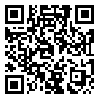Volume 2, Issue 1 And Supplement (Winter 2021)
J Vessel Circ 2021, 2(1 And Supplement): 36-36 |
Back to browse issues page
Download citation:
BibTeX | RIS | EndNote | Medlars | ProCite | Reference Manager | RefWorks
Send citation to:



BibTeX | RIS | EndNote | Medlars | ProCite | Reference Manager | RefWorks
Send citation to:
Ashayeri Ahmadabad R, Mirzaasgari Z, Kiaani A, Kheir khah P, Hosseiny M, Sohrabi A, et al . A Randomized Controlled Trial of Neuroprotective Effects of N-Acetyl-Cysteine in Patients with Acute Ischemic Stroke. J Vessel Circ 2021; 2 (1) :36-36
URL: http://jvessels.muq.ac.ir/article-1-124-en.html
URL: http://jvessels.muq.ac.ir/article-1-124-en.html
Rezan Ashayeri Ahmadabad * 
 1, Zahra Mirzaasgari2
1, Zahra Mirzaasgari2 
 , Amir Kiaani3
, Amir Kiaani3 
 , Parnian Kheir khah4
, Parnian Kheir khah4 
 , Melina Hosseiny5
, Melina Hosseiny5 
 , Ali Sohrabi6
, Ali Sohrabi6 
 , Ali Rafati4
, Ali Rafati4 
 , Maryam Bahadori4
, Maryam Bahadori4 
 , Masoud Mehrpour7
, Masoud Mehrpour7 
 , Azadeh Eshraghi8
, Azadeh Eshraghi8 


 1, Zahra Mirzaasgari2
1, Zahra Mirzaasgari2 
 , Amir Kiaani3
, Amir Kiaani3 
 , Parnian Kheir khah4
, Parnian Kheir khah4 
 , Melina Hosseiny5
, Melina Hosseiny5 
 , Ali Sohrabi6
, Ali Sohrabi6 
 , Ali Rafati4
, Ali Rafati4 
 , Maryam Bahadori4
, Maryam Bahadori4 
 , Masoud Mehrpour7
, Masoud Mehrpour7 
 , Azadeh Eshraghi8
, Azadeh Eshraghi8 

1- Neurologist, Iran University of Medical Sciences, Firoozgar Hospital
2- Assistant Professor in Neurology, Iran University of Medical Sciences, Firoozgar Hospital
3- Associate Professor of Toxicology, Kermanshah University of Medical Sciences, School of Pharmacology
4- General physician, Iran University of Medical Sciences
5- Advanced Diagnostic and Interventional Radiology Research Center, Tehran University of Medical Sciences.
6- Gastroenterologist, Iran University of Medical Sciences, Firoozgar Hospital
7- Associate Professor in Neurology, Iran University of medical sciences, Firoozgar Hospital
8- Assistant professor in Clinical Pharmacy, Iran University of medical sciences, Faculty of Pharmacy
2- Assistant Professor in Neurology, Iran University of Medical Sciences, Firoozgar Hospital
3- Associate Professor of Toxicology, Kermanshah University of Medical Sciences, School of Pharmacology
4- General physician, Iran University of Medical Sciences
5- Advanced Diagnostic and Interventional Radiology Research Center, Tehran University of Medical Sciences.
6- Gastroenterologist, Iran University of Medical Sciences, Firoozgar Hospital
7- Associate Professor in Neurology, Iran University of medical sciences, Firoozgar Hospital
8- Assistant professor in Clinical Pharmacy, Iran University of medical sciences, Faculty of Pharmacy
Abstract: (859 Views)
Background and Aim: To investigate the neuroprotective effects of NAC (N-Acetyl-Cysteine) in patients with AIS (Acute Ischemic Stroke).
Materials and Methods: The study was a single blind placebo controlled trial. 62 patients were enrolled in the study, 31 patients in each arm. NAC was infused for the intervention group with doses of 100 mg/kg stat on admission then 10 mg/kg/hour for 10 hours in addition to standard treatment. The control group only received standard treatment. The blood sample for measuring MMP-9 (Matrix Metalloproteinase 9) was collected from both groups before and 24 hours after receiving NAC. NIHSS (National Institutes of Health Stroke Scale) was calculated for both groups before therapy, 24 hours, 2 weeks, 1 month and 3 months after therapy.
Results: Mean NIHSS in the intervention and control groups were 6.87±4.15 and 8.11±4.12 (p-value = 0.231) on admission, 4.52±3.82 and 5.87±4.36 (p-value = 0.193)24 hours after admission, 3.06±2.74and 4.93±4.69 (p-value = 0.061)2 weeks later, 2.39±2.41and 3.66±4.98 (p-value = 0.2 25) one month later, and, 1.07±2.12and 2.36±2.28 (p-value = 0.511) 3 months later respectively, which were not statistically significant. Also, the relationship between MMP9 and NIHSS was evaluated using Pearson correlation coefficient. There was no significant correlation between MMP9 changes and neurological deficits in any of the time intervals. In both intervention and control groups, the amount of MMP9 24 hours after injection was decreased dramatically (p-value = 0.000) and showed that MMP9 reduction was not dependent on NAC injection.
Conclusion: NAC injection did not show clinical and laboratory benefits in patients with AIS in addition to standard therapy.
Materials and Methods: The study was a single blind placebo controlled trial. 62 patients were enrolled in the study, 31 patients in each arm. NAC was infused for the intervention group with doses of 100 mg/kg stat on admission then 10 mg/kg/hour for 10 hours in addition to standard treatment. The control group only received standard treatment. The blood sample for measuring MMP-9 (Matrix Metalloproteinase 9) was collected from both groups before and 24 hours after receiving NAC. NIHSS (National Institutes of Health Stroke Scale) was calculated for both groups before therapy, 24 hours, 2 weeks, 1 month and 3 months after therapy.
Results: Mean NIHSS in the intervention and control groups were 6.87±4.15 and 8.11±4.12 (p-value = 0.231) on admission, 4.52±3.82 and 5.87±4.36 (p-value = 0.193)24 hours after admission, 3.06±2.74and 4.93±4.69 (p-value = 0.061)2 weeks later, 2.39±2.41and 3.66±4.98 (p-value = 0.2 25) one month later, and, 1.07±2.12and 2.36±2.28 (p-value = 0.511) 3 months later respectively, which were not statistically significant. Also, the relationship between MMP9 and NIHSS was evaluated using Pearson correlation coefficient. There was no significant correlation between MMP9 changes and neurological deficits in any of the time intervals. In both intervention and control groups, the amount of MMP9 24 hours after injection was decreased dramatically (p-value = 0.000) and showed that MMP9 reduction was not dependent on NAC injection.
Conclusion: NAC injection did not show clinical and laboratory benefits in patients with AIS in addition to standard therapy.
Type of Study: Research |
Subject:
stroke
Received: 2021/08/25 | Accepted: 2021/02/28 | Published: 2021/02/28
Received: 2021/08/25 | Accepted: 2021/02/28 | Published: 2021/02/28
Send email to the article author
| Rights and permissions | |
 |
This work is licensed under a Creative Commons Attribution-NonCommercial 4.0 International License. |




